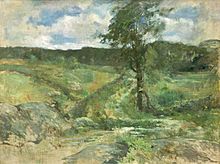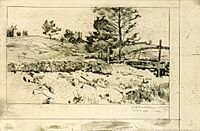Branchville, Connecticut facts for kids
Quick facts for kids
Branchville, Connecticut
|
|
|---|---|

Branchville (ca. 1888-1889) by John Henry Twachtman (1853-1902)
|
|
| Country | |
| State | |
| County | Fairfield |
| City | Ridgefield |
| Time zone | UTC-5:00 (Eastern) |
| • Summer (DST) | UTC-4:00 (Eastern) |
| Area code(s) | 203 |
Branchville is a small neighborhood in Ridgefield, Fairfield County, Connecticut. It is also known for its Metro-North train station, called Branchville station. Before 2020, Branchville was officially listed as a "census-designated place" (CDP). This means it was a special area used for counting people during the census.
Some people think Branchville is part of a nearby community called Georgetown. This is because many homes and businesses share Georgetown's phone numbers. However, others disagree. They point to a vote from the 1950s where the community decided not to use the Georgetown Post Office. The Branchville CDP is only located within the town of Ridgefield.
Exploring Branchville's Past
How Branchville Got Its Name
Branchville got its name from the Danbury and Norwalk Railroad. A "branch" line was built from this main railroad. This line went west to Ridgefield village. It was about four miles long and went uphill. Branchville is about 342 feet (104 meters) above sea level. The old village station was much higher, around 900 feet (274 meters) up.
Early Names for the Area
Long ago, Native Americans called this area Wheer Cock. Later, it was known as Copps Corner. This name came from a man from Norwalk who surveyed the town. He was also the first town clerk in the early 1700s. When the railroad line from Norwalk to Danbury was finished in 1852, the neighborhood had new names. It was first called Beers Station or Ridgefield Station. These names came from the train stop there.
When "Branchville" First Appeared
The name "Branchville" was first written down in 1870. This was in a deed for a piece of land in Ridgefield. This was the same year the branch train line was built. This suggests that the railroad, not the people living there, created the name. They likely wanted to tell this station apart from the new one in Ridgefield center. Before this, the station was known as Ridgefield Station or Beers Station.
An old map from 1893 incorrectly labeled this area as "Plattsville."
Branchville's Industrial Boom
Before the railroad, Branchville was mostly farmland with a few mills. But the arrival of the train changed everything. It helped the area grow into a busy, small industrial community. It had mills, stores, a hotel, a factory that made machines, and a post office.
In 1876, something exciting happened. A.N. Fillow started digging for mica in Branchville. Two mineral experts from Yale University visited. They found new minerals in the rocks there. These minerals had never been seen before! They gave money to help expand the mining operation. Historians say the mine produced between seven and nine minerals that were new to science. Over time, the mine produced a lot of quartz, feldspar, mica, beryl, spodumene, and columbite.
The Railroad's Later Years
Trains carried passengers on the Ridgefield branch line until 1925. Freight, or goods, were carried until 1964. Today, most of the old train track path is still there. It has gravel but no rails. It is now used for the Eversource Energy power line. It is also a town "Rail-Trail" for walkers, created in the 1990s. Some other parts of the track bed were sold to nearby landowners.
Learning in Branchville
Early Schools in Branchville
Branchville has had its own school district since the mid-1700s. It was first called the "Ridgefield Station District." The schoolhouse was used until the fall of 1937. After that, children started riding buses to Garden School in the village.
New Schools and Changes
A new Branchville School opened in 1969 on lower Florida Road. It was used until 1983. It closed because fewer students were enrolling. The building was then used as offices for the Ridgefield Board of Education. In 1994, more students were enrolling again. Voters agreed to reopen the school.
Weir Farm: A Place for Artists

Weir Farm National Historic Site is located in Ridgefield and Wilton. It is considered part of Branchville. The National Park Service manages this special place. Weir Farm celebrates the life and work of Julian Alden Weir. He was an impressionist painter. Other artists also stayed at the farm. Famous visitors included Childe Hassam, Albert Pinkham Ryder, John Singer Sargent, and John Twachtman.
Later, an artist named Sperry Andrews worked to protect Weir Farm. In 1990, the U.S. government made it a National Historic Site.
Weir's Artistic Home
In 1882, Julian Alden Weir bought a 153-acre farm. He traded $10 and a painting for it. Weir and the artists he invited painted many pictures of Branchville and the beautiful landscapes around it.
Weir Farm was chosen to represent Connecticut on a special quarter. This coin was made by the U.S. Mint in 2020.

